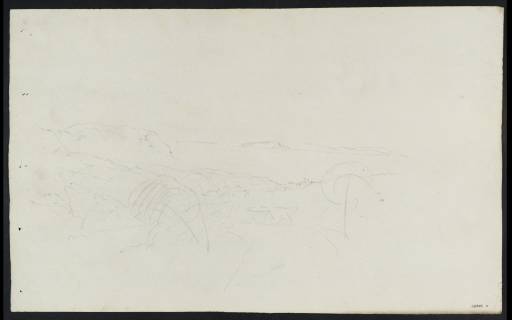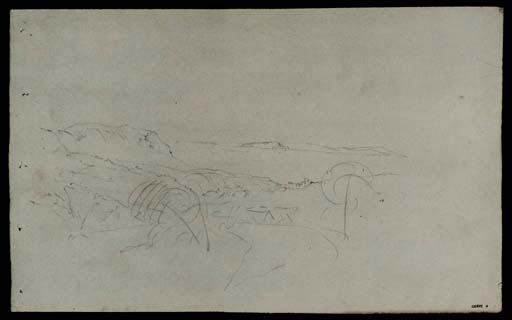Joseph Mallord William Turner ?Minehead and the Bristol Channel from near Dunster 1811
Image 1 of 2
Joseph Mallord William Turner,
?Minehead and the Bristol Channel from near Dunster
1811
Joseph Mallord William Turner 1775–1851
?Minehead and the Bristol Channel from near Dunster 1811
D08952
Turner Bequest CXXVI 6
Turner Bequest CXXVI 6
Pencil on white wove paper, 200 x 324 mm
Inscribed by John Ruskin in red ink ‘6’ bottom right (now very faint)
Blind-stamped with Turner Bequest monogram bottom right
Stamped in black ‘CXXVI 6’ bottom right
Inscribed by John Ruskin in red ink ‘6’ bottom right (now very faint)
Blind-stamped with Turner Bequest monogram bottom right
Stamped in black ‘CXXVI 6’ bottom right
Accepted by the nation as part of the Turner Bequest 1856
References
1909
A.J. Finberg, A Complete Inventory of the Drawings of the Turner Bequest, London 1909, vol.I, p.357, CXXVI 6, as ‘Rocks on coast’.
1997
Eric Shanes, Turner’s Watercolour Explorations 1810–1842, exhibition catalogue, Tate Gallery, London 1997, pp.82, 96 (cited on latter page as ‘CXXVI 7’).
Without specifying the viewpoint, Eric Shanes has suggested the subject is ‘Porlock Hill and town’,1 looking north to the Somerset coast, with South Wales prominent on the horizon across the Bristol Channel. Prospects from the tight bends of Porlock Hill, west of Porlock itself, and from Crawter Hill to its south are now largely obscured by trees. However, the profile of the hill on the left appears less characteristic of the slopes above Porlock Weir than of North Hill, overlooking Minehead in the next bay east of Porlock, as seen from the south-east near Ellicombe on the road from Minehead to Dunster. This identification is suggested tentatively as Minehead has since grown substantially, occupying much of North Hill and the plain below. There is a view of the town and hill from the coast on D08956 (Turner Bequest CXXVI 10), and Turner drew Dunster’s Butter Cross, not far to the east along the road from Ellicombe, on D08955 (CXXVI 9).
Shanes has also suggested that the present drawing is the basis for a watercolour ‘beginning’ watermarked 1828 (Tate D25216; Turner Bequest CCLXIII 94), listed by Finberg as ‘Park, with river in middle distance’.2 He relates it to Turner’s Picturesque Views in England and Wales, dating it to about 1834 by association with another watercolour beginning, of Dunster Castle (Tate D36222; Turner Bequest CCCLXIV a 360), perhaps made ‘during the same session of work’3 – see under D08953 (CXXVI 7) in the present sketchbook. However, Ian Warrell has since convincingly identified the ‘Porlock’ watercolour as a view of Rouen from the north, comparing it with precise 1820s pencil and ink drawings.4
There is a confirmed view of Porlock Bay from the east on D08958 (CXXVI 12).
Technical notes:
There are five sets of stitch holes near the left-hand edge, a short tear towards the top of the right-hand edge, and a nick towards the bottom of the same edge. The stitch holes precisely match those on other sheets, but only when the sheet is flipped, indicating that the drawing was originally inverted on the verso when it was originally bound with the others as a sketchbook.
Verso:
Blank
Matthew Imms
January 2011
How to cite
Matthew Imms, ‘?Minehead and the Bristol Channel from near Dunster 1811 by Joseph Mallord William Turner’, catalogue entry, January 2011, in David Blayney Brown (ed.), J.M.W. Turner: Sketchbooks, Drawings and Watercolours, Tate Research Publication, December 2012, https://www


